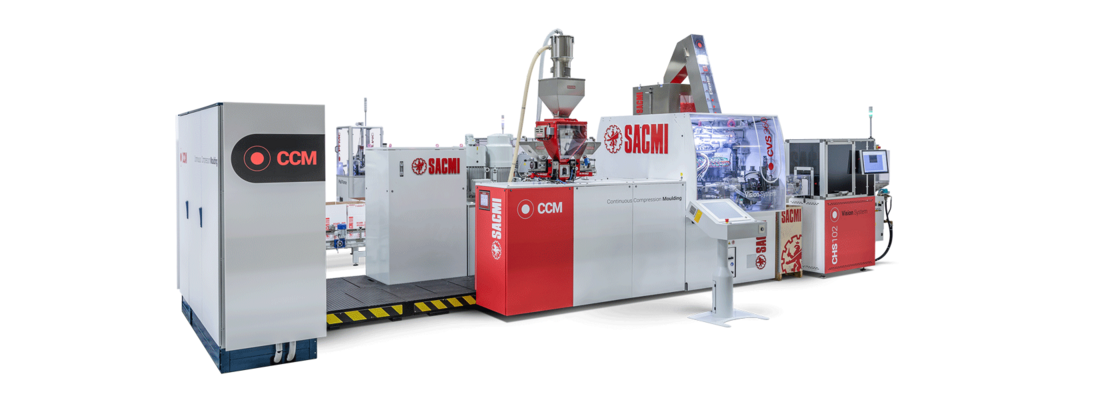The SACMI range transforms sustainability into opportunity and makes it a source of competitive advantage, as the latest generation of machines and control systems on show at the fair will clearly demonstrate.
Behind these solutions lie cutting-edge development and prototyping of innovative packaging that uses new eco-sustainable materials and an approach to quality control that makes extensive use of AI. This doesn’t just mean better products: it also simplifies workers’ tasks, making line management more proactive and optimizing man-machine resources.
New IPS 300: state-of-the-art performance, versatility, ease of use
IPS 300 is the latest SACMI preform press, soon to be presented at K. It completes a range that has led the market for 10 years, providing solutions that offer excellent performance, low consumption, fast set-ups and quick changeovers.
Like the IPS 400, the new IPS 300 features outstanding compatibility with various mold types, including those produced by third parties. Workers’ tasks are streamlined at every stage - from start-up to size changeovers and control of auxiliary units - and reliability is guaranteed by using only the highest quality components.
From a product perspective, the IPS 300 is designed to work with 24-cavity molds for 48 mm necks and up to 96 cavities for 30 mm necks. Further opportunities include a 128-cavity configuration for 26/22 mm necks, a unique solution within today’s range of available technologies.
Outstanding design makes the IPS 300 one of the highest-performing machines on the market. The press has a lock-to-lock time of just 2.1 seconds and extremely fast cycle times, characteristics that also stem from the innovative patented COOL+ after-cooler (inside cooling system) which improves thermal efficiency and boosts productivity. In terms of versatility, the IPS 300 meets every production need thanks to a wide range of plasticizing units (from 625 to 1220 kg/h) and various premium kits designed to streamline system use and enhance finished product quality.
At just 0.2 kWh/kg, the IPS 300 has the lowest energy consumption on the market. This is achieved via a combination of KERS (kinetic energy recovery system) and adaptive self-tuning. On this machine, automation is designed to ensure immediate economic advantages for the customer: based on a Bekhoff TwinCAT architecture with EtherCAT fieldbus, the press infrastructure opens the industry to IoT opportunities (self-learning, predictive controls).
Above all, the IPS 300 is the first press on the market to incorporate the PVS 156 from the SACMI Preform Vision System range directly on the machine, thus maximizing inspection accuracy, precision and speed. Note that the PVS156 can complete inspection of a 96-preform molding in no more than 5 minutes.
The rPET approach: extended range and products
The recyclable material par excellence, PET has been the focus of the industry’s development efforts for years. Such developments concern both the technology - presses capable of processing ever-higher percentages of recycled resins - and research into new materials and applications.
For several years now, all standard SACMI IPS models have been able to process up to 100% rPET and up to 50% PET in recycled flake form. The innovative in-press hopper to be presented by SACMI at the international K fair allows for further acceleration on this front by increasing the flake share to 70-75% and providing multiple advantages in terms of user-friendliness and product quality. This is because this single hopper optimizes the flake-granule mix but without the complexities that stem from having to manage two distinct processing hoppers.
This proposal offers the dual advantages of process innovation and process simplification, which SACMI combines with intense Research & Development into the use of PET instead of other resins (for example, to replace the traditional polystyrene used in the dairy sector). Thanks to its uniquely skilled Rigid Packaging Laboratory team and their understanding of materials and processes, SACMI will also preview some of the latest producible items - such as new yogurt cartons made of transparent PET - that are driving sustainability by opening up unprecedented opportunities from both a product and market perspective.
CCM technology, intrinsic advantages and new digital controls for quality and energy saving
Compression is an intrinsically advantageous technology, and on flat top cap manufacturing lines SACMI is the undisputed world leader. The ability to design new products - such as PET dairy cartons - stems directly from the specific characteristics of the compression process, such as the lower material extrusion temperature, the absence of a gate, and hot runners in the mold. The result? Greater freedom to manage recycled and/or high-viscosity materials and the ability to manufacture light, high quality, high performance products.
SACMI has a world-beating capacity to drive market evolution from both a materials and processes-technologies viewpoint. In the context of key development trends in the PET sector, the international K fair offers a unique opportunity to showcase the latest generation of advanced controls on CCM cap presses, such as the innovative CM-Flow extruder which reduces total electricity consumption on the press by up to 9%. Note that the extruder can also be installed on existing machines. Because the screw is connected directly to the motor, CM-Flow can process up to 200 kg/h of resin - the same as a conventional 75 mm extruder - but with a plasticizing screw with a diameter of just 35 mm and a footprint as small as 1 meter. In-the-field tests have also demonstrated up to 50% fewer black spots: all other factors remaining equal, that means a net increase in quality and efficiency.
But that’s not all. In addition to the new extruder, SACMI customers can also count on next-gen CCMs able to mount the new Smart Pack, an advanced digital package that incorporates advanced on-board sensors and controls. These boost plant availability, extend the lifespan of its components and - last but not least - simplify the workers’ tasks, drastically reducing process errors.







